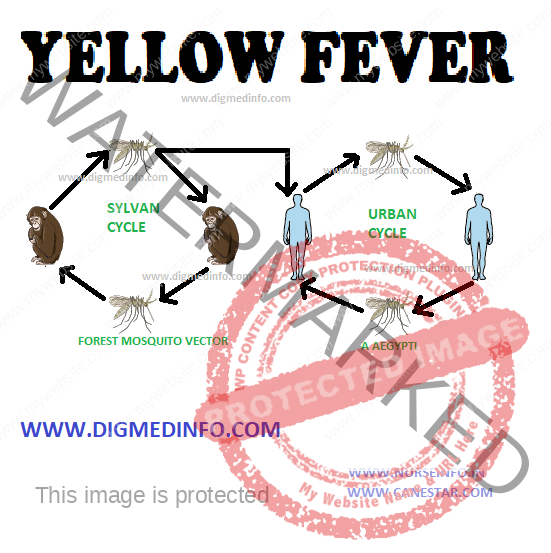YELLOW FEVER – Etiology, Distribution and Incidence, Distribution and Incidence, Transmission and Epidemiology, Pathogenesis and Pathology, Clinical Features, Diagnosis, Treatment and Prevention
Yellow fever is an acute mosquito-borne infection of varying severity characterized by the triad of hepatitis, hemorrhagic diathesis and proteinuria.
Etiology
The causative virus is an arbo virus belonging to the genus Flavivirus, in the family Flaviviridae.
Distribution and Incidence
Yellow fever is prevalent in many parts of Africa, tropical parts of South America and Panama. The presence of the efficient vector Aedes aegypti mosquitoes and the non-immune population pose a threat of the disease spreading, if the virus is introduced.
Transmission and Epidemiology
Epidemic (urban) yellow fever is transmitted from human to human by Aedes aegypti mosquitoes. Infected monkeys and the vector mosquitoes maintain the reservoir of infection in the jungle. These act as a source of infection when the humans intrude into endemic areas.
Pathology and Pathogenesis
The incubation period after an infectious mosquito bite is 3 to 6 days. Liver and kidneys show maximal lesions but hemorrhage may occur in all organs. Hepatic changes include widespread necrosis, and degeneration of liver cells. Renal changes include acute tubular necrosis and subcapsular hemorrhages. Bleeding diathesis is due to depletion of hepatic clotting factors, intravascular coagulation, and platelet abnormalities. Direct damage to the myocardium, kidneys and other organs and the effects of vasoactive cytokines, lead to fatal complications such as multi-organ failure and shock.
CLINICAL FEATURES
In the majority of cases, the disease is a self limited with fever and myalgia. 25 to 50% of cases may develop the full syndrome with complications such as hemorrhages, jaundice, renal involvement and shock.
The first stage (i.e. period of infection) is due to the direct effect of the virus. It starts abruptly with fever, headache and myalgia. In severe illness there is nausea vomiting, abdominal pain and distressing pain in the back, and limbs. There is relative bradycardia. This stage lasts about 3 days and by 4th day the temperature comes down and the second stage (period of remission) starts.
Many cases recover without going to the third stage. Some progress to the third stage (period of intoxication). It starts after a day or a few days, with resumption of high fever, body pains, nausea, vomiting, abdominal pain and changes in the level of consciousness. Bradycardia, jaundice, wide spread hemorrhages and renal failure may supervene. Death is due to hepatic or renal failure and shock.
Diagnosis
In endemic areas, fever, leukopenia and proteinuria with or without jaundice should suggest the possibility of yellow fever. Specific diagnosis is established by the isolation of the virus from the blood in the first few days of fever or demonstration of rising titer of antibodies in serum.
Treatment
There is no specific antiviral treatment. Symptomatic and supportive measures should be instituted. Hepatic and renal failure has to be anticipated and managed accordingly.
Prevention
Vaccination using live attenuated vaccine (17D strain) is very effective. Vaccination gives immunity starting from ten days and full protection for 10 years. Though side effects are generally negligible, children below 9 months may develop encephalitis. Pregnancy is not a contraindication for vaccination. Many countries insist on yellow fever vaccination for persons entering the country or remaining during transit, if they come from endemic areas. Persons travelling to endemic areas have to take vaccination.


